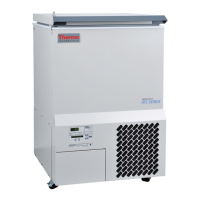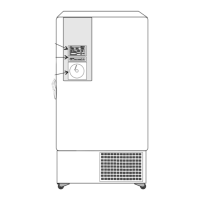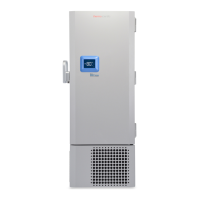
Do you have a question about the Thermo Scientific HERAfreeze HFU Series and is the answer not in the manual?
| Model | HERAfreeze HFU Series |
|---|---|
| Type | Upright Freezer |
| Control System | Microprocessor control |
| Display | Digital display |
| Interior Material | Stainless steel |
| Energy Efficiency Class | A+ |
| Capacity | Varies by model |
| Capacity (cu. ft.) | Varies by model |
| Power Supply | 230V, 50/60Hz |
| Certifications/Compliance | CE, UL |
| Defrost Type | Manual |
| Power Consumption | Varies by model |
| Dimensions (HxWxD) | Varies by model |
| Weight | Varies by model |
Key information for users and installers regarding freezer setup and operation.
Contact details and resources for obtaining information and support for Thermo Scientific products.
Detailed explanation of the freezer's control panel interface, buttons, and indicators.
Instructions for removing the freezer from its pallet and selecting a suitable operating location.
Information on RS-232 ports, remote alarms, and analog output connections.
Steps for powering on, setting operating temperature, and configuring alarms.
Setting security codes and understanding the default operational run mode of the freezer.
Guide to entering calibration mode and calibrating the primary temperature sensor for accuracy.
Procedures for testing high/low alarms and checking system/BUS battery status.
Procedures for testing system and BUS battery status.
Configuring display, access codes, and clearing high stage alarms.
Configuring RS485 address, backup system type, and excursion settings.
Explains alarms for High Stage Failure, Micro Board issues, and Lost Communication.
Procedures for cleaning the air filter and condenser for optimal performance.
Instructions for defrosting the freezer and replacing the internal battery.
Summary of scheduled maintenance tasks for ensuring unit longevity and performance.
Steps for installing the BUS injection assembly and temperature probe.
Explanation of BUS panel, testing, and setting the BUS set point.
Guide to installing, changing programs, and calibrating the optional chart recorder.
Defines operational safety requirements and the product's intended applications.
Details the standard warranty coverage, period, and exclusions for the freezer.
Specific warranty terms applicable to international dealers and their customers.
Essential precautions for safely handling liquid nitrogen and recommended protective gear.
Safety guidelines for storing, using, and disposing of liquid nitrogen in ventilated areas.
Safety guidelines for storing and disposing of liquid CO2 in ventilated areas to prevent hazards.











